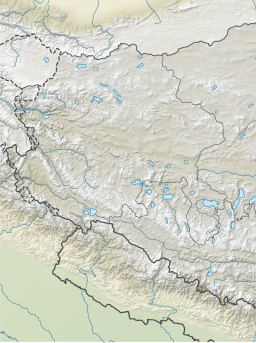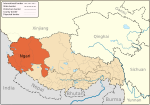Bangda Lake
| Bangda Lake | |
|---|---|
| Yeshil Kul | |
 Sentinel-2 image (2021) | |
| Location | Rutog County, Ngari Prefecture, Tibet Autonomous Region, China |
| Coordinates | 34°56′56″N 81°34′16″E / 34.94889°N 81.57111°E |
| Catchment area | 3,314.5 km2 (1,300 sq mi) |
| Basin countries | China |
| Max. length | 15 km (9 mi) |
| Max. width | 9.7 km (6 mi) |
| Surface area | 106.5 km2 (0 sq mi) |
| Surface elevation | 4,902 m (16,083 ft) |
| References | [1] |
Bangda Lake (Tibetan: པང་བཏགས་མཚོ, Wylie: pang btags mtsho, THL: pang tak tso; Chinese: 邦达错; pinyin: Bāngdá Cuò),[a] formerly called Yeshil Kul,[2][b] is a glacial lake in Ngari Prefecture in the northwest of the Tibet Autonomous Region of China. It lies south of the western Kunlun Mountains, only a few kilometres to the southeast of Guozha Lake (Lake Lighten).[2] Located at an altitude of 4902 metres, it covers an area of 106 square kilometres with a maximum depth of 21.6 metres and has a drainage basin containing 90 glaciers.[3]
Location
Located at an elevation of 4,902 metres (16,083 ft), the Bangda Lake covers an area of 106 square kilometres with a maximum depth of 21.6 metres and contains 90 glaciers.[4]
Yeshil Kul is located along an ancient travel route between
A "Xinjiang–Tibet Highway" was laid by the
Maps
-
Map including Yahsierh Tso (Yeshil Kul)
-
Map including Bangdag Co
Notes
References
- ISBN 7-03-006706-1.
- ^ a b
Hedin, Sven (1999), Trans Himalayas - Discoveries and Adventures in Tibet - 3 Vols., Asian Educational Services, pp. 19–, ISBN 978-81-206-1416-1
- ISSN 0260-3055.
- ^
Li, Shijie; Shi, Yafeng (1992). "Glacial and lake fluctuations in the area of the west Kunlun mountains during the last 45 000 years". Annals of Glaciology. 16: 79–84. ISSN 0260-3055.
- ^ "Journey of Carey and Dalgleish in Chinese Turkistan and Northern Tibet and General Prejevalsky on the Orography of Northern Tibet", Royal Geographical Society (Great Britain), Supplementary Papers, J. Murray, 1893, p. 11 – via archive.org
- ISBN 978-81-212-1024-9
- ISBN 978-0-415-58443-2– via archive.org,
By May 1951, the construction of the 208.5 kilometre road had been completed at the cost of a dozen deaths and injuries to over 100 soldiers
- ^ Keriya trail, OpenStreetMap, retrieved 14 November 2022.
- ^ Mullik, B. N. (1971), My Years with Nehru: The Chinese Betrayal, Allied Publishers, p. 197 – via archive.org,
In 1953, we reported that the jeep track to Rudok had been completed and regular jeep traffic had commenced. It was because of these troop movements and the road building activity that the Chinese had refused to allow a trade mart to be opened at Rudok.
- ^ Kongka La Highway, OpenStreetMap, retrieved 14 November 2022.




